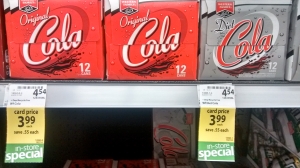Coke is now sold in 20, not 24, packs!

So to determine the best buy, I couldn’t just double. I use that strategy all the time; it’s my Frank’s RedHot. The exclamation point is there because I think that 20 leads to more strategies than 24. (Some of) these strategies are listed in my 5 Practices monitoring tool below. I’m curious if you think that I have anticipated likely student responses correctly. What incorrect strategy could I have anticipated? I wonder how you’d purposefully sequence these responses during the discussion.
More than SWBAT solve problems using unit rates, I want my students to recognize that there are many ways to solve rate problems and understand that we can easily compare rates with one term the same. This big ideas connects the strategies. In the fourth strategy above, we can think of 24 cans as a unit. Call it a “two-four” (Is that just a Canadian convention?) or a “flat” (Are we cool with calling the Pepsi cube a flat?). In fact, Save-On-Foods wants us to think of 24 as one; we’re encouraged to buy two packs of 12, a composed unit. For this task, I’d prefer that they didn’t, so I went back to the store and found this:
Comparing 20 packs with 15 packs is more likely to lead to common multiples than comparing 20 packs with 24 packs as above. Numbers matter. There’s this, but it doesn’t get us a clear winner:
Recommended: Dan knocks motivating unit rates out of the park; Christopher asks “What is one?”






2 Replies to “Cola Comparison”